Take The A Train is one of the most classic jazz standards you’ll ever come across. Composed by Billy Strayhorn, the tune quickly became the featured tune of The Duke Ellington Orchestra after his son Mercer Ellington found a draft of the tune in the trash…
Clearly, Strayhorn was his own worst critic, so it’s a good thing that Mercer went dumpster diving that day because if he didn’t, who knows if this legendary hit would have materialized.
But here’s the thing…
While at one point Take The A Train was the pop tune everyone wanted to hear, in today’s world, many young aspiring jazz musicians think of it as old, dated, and maybe even a bit cheesy.
So if this is you, then it’s time to reframe how you hear and think about this classic standard because regardless what you’re thinking right now, it’s actually a timeless tune that you need to add to your repertoire.
The best way to reframe a tune in your mind is to find a version of the song that really affects you, listen to it over and over, transcribe your favorite ideas and deconstruct how your hero makes the magic happen.
Today we’ll be doing this with Paul Desmond’s solo over Take The A Train – Every time I hear him play over this form, the changes dissolve in my mind…
I don’t think of Take The A Train as cheesy, boring, or stale, but instead fresh, exciting, and melodic.
And by studying Desmond’s solo today and all of his intricate improvisational techniques, it can do the same for you.
Let’s get started…
Take The A Train Chord Changes
First, let’s breakdown the chord changes on Take The The A Train…
With a straightforward AABA 32 bar form, the first A Section starts on the I chord and then quickly moves directly to a II dominant chord.
However, this II7 chord includes an interesting alteration – a b5, which slightly changes the flavor of this chord.

This interesting chord is then followed by a simple ii V7 and a Turnaround, which moves us to the next A Section. (Note that the Rhythm section sometimes plays Eb7, the tritone sub of A7, during the solos)
Now the second A Section of the tune is exactly the same as the first, but instead of a Turnaround taking us back to the top it resolves to The Tonic, C Major.

Moving from the C7, the Bridge of A Train of course starts on the IV (F Major), and then moves back to the D7 to D- G7 that we’ve seen before throughout the tune, but here the D7 is a little different…

It doesn’t have the b5 and it’s really heard as operating momentarily in the key of F, making it a VI7 chord.
Still though, it could be thought about as II7 in the Tonic key like the other D7 chords. It’s very common for chords to have these overlapping moments in a tune, where they can be viewed from multiple angles.
After the Bridge is just one last A Section, and that’s all the chord changes to Take The A Train.
It’s quite simple and it’s a sequence of chord changes that you see over and over within the jazz repertoire, especially the formula of the A sections:

Commit this formula of chords to memory and make sure you understand how the chords are functioning – a huge topic that we explore in great detail throughout our new course Jazz Theory Unlocked.

Paul Desmond on A Train
Now that you have a solid idea of the form and changes in your mind, it’s time to fall in love with Paul Desmond’s solo over this classic jazz standard…
Check out his first chorus on Take The A Train and listen closely for the form of the tune, and the specific chord qualities.
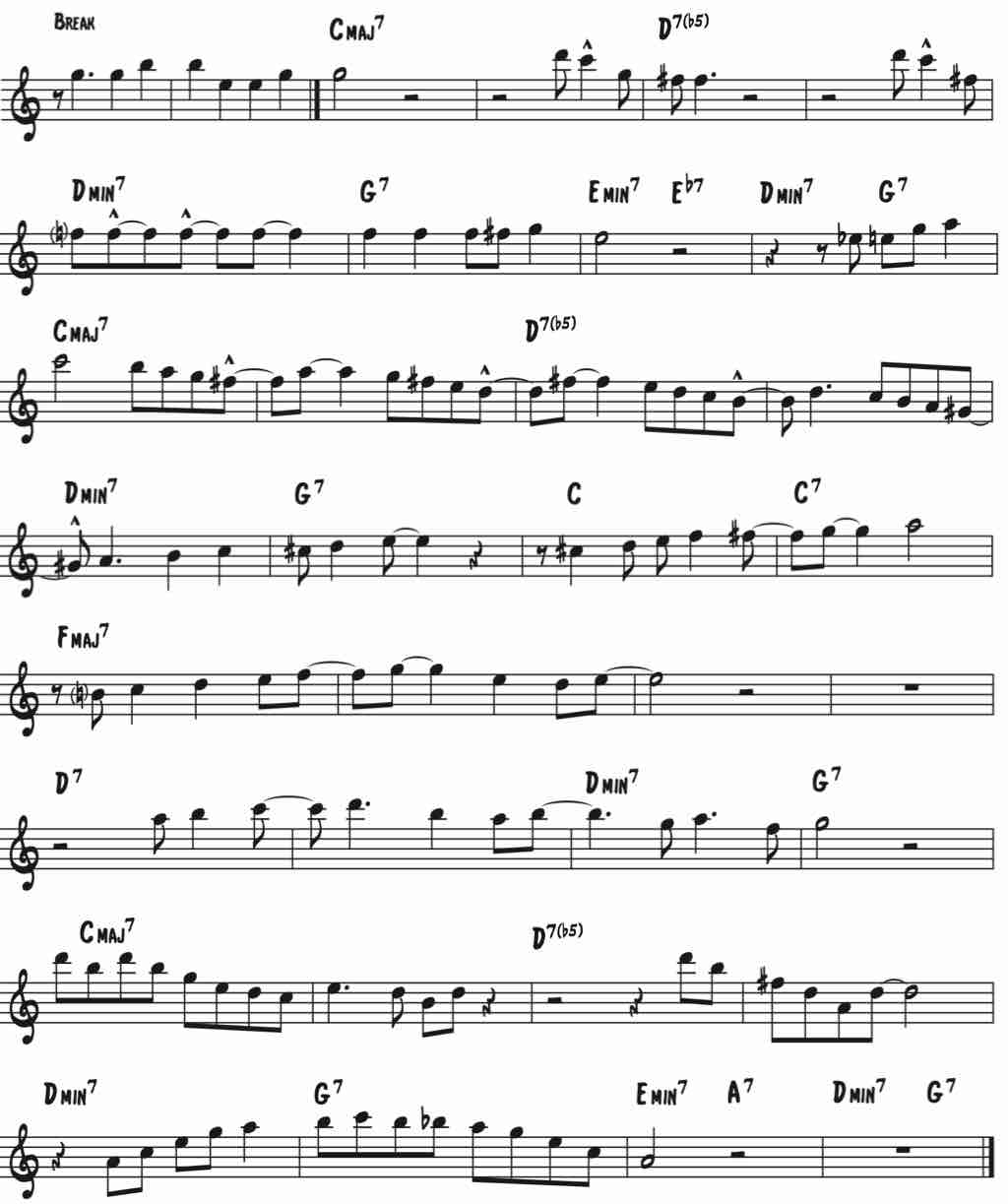
This solo is full of creativity – from the melodic lines to the rhythms he uses, it’s packed with ideas to expand and challenge your notion of what you thought possible on this tune.
In particular, we’re going to study 5 key strategies that Paul Desmond uses on Take The A Train that will help your jazz improvisation concept:
- His use of guide tone lines
- How he approaches the 2nd chord
- What types of rhythms he utilizes
- His approach to ii V7s
- And how he makes use of quotes
Combine these 5 strategies, and Take The A Train will soon become an excellent vehicle for your own creativity.
First let’s take look into how Desmond uses guide tone lines…
1. Find Simple Guide Tone Lines
Guide tone lines are one of the first things jazz teachers like to introduce, and for good reason…they outline the harmony and they seem pretty simple…
But the problem is, guide tone lines are often seen as just an exercise with 3rds and 7ths rather than an improvisational device that you can use in your solo.
Here’s the thing – if you expand your idea about what guide tone lines can be and you practice making them actually sound musical, you can use them as the foundation for your improvisational ideas, just as you’ll hear Desmond do.
Take a listen to Desmond here, and try to hear the musical skeleton behind the entire first 8 bars of his solo.

Can you hear it? The skeleton within the line looks like this…

Desmond uses specific chord tones from each chord as targets to aim at. He starts with the 5th of C, and then moves down chromatically to 3rds, 7ths, and roots of the chords.
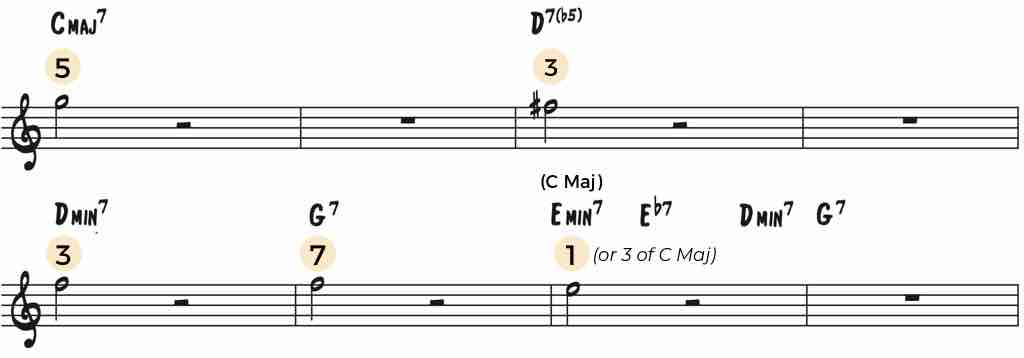
All the other notes in these 8 bars are embellishments of this basic guide tone line. So the basis for this entire section comes from a crucial skill – the ability to play melodic guide tone lines.
Now, a great way to develop this skill and learn how to create musical guide lines through the changes that you can actually use in your solos is by writing out some possible skeleton lines and working on them…

Remember, these aren’t your typical guide lines that only use 3rds and 7ths…
While it’s a great exercise to practice just playing the 3rd or 7th of each chord, you need to move beyond this basic exercise and learn how to craft simple skeleton lines through the harmony that use ANY chord tone.
That’s right, you can use any chord tone. The 5th, the root, the b5, or b9. Anything works…but it’s more about how one chord tone moves to the next and the overall shape and character you’re creating in the overall line.
For example, maybe start on the 5th like Desmond does, but move chromatically up to the b5/#11 of the D7 chord, followed by some chromatic movement to the 5th of D minor, the b9 of G7, and the 3rd of E minor (or the 5th of C major if we’re resolving to the Tonic)
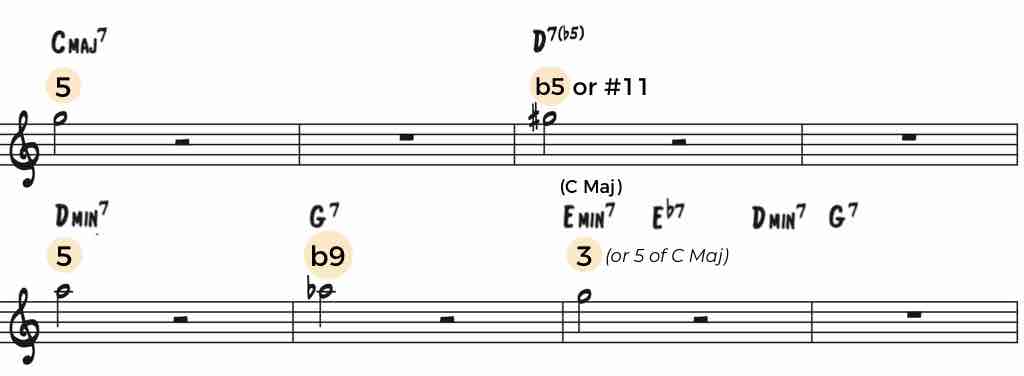
Or perhaps begin on the 7th of the Tonic and see where that might lead your skeleton line…
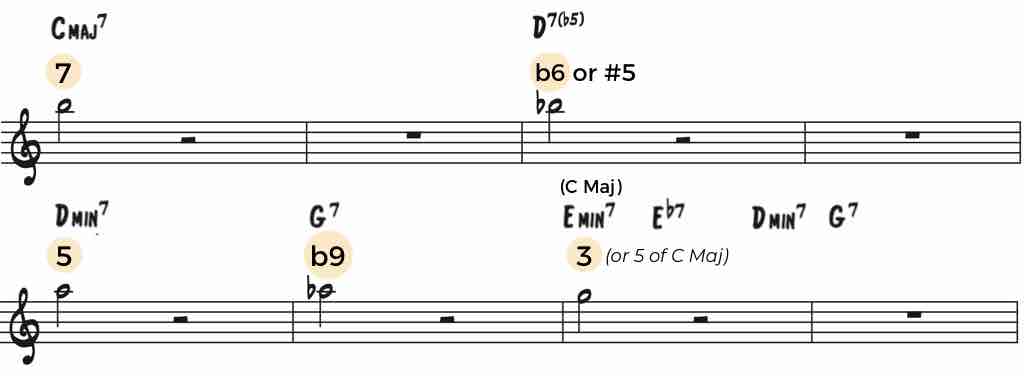
When you have all possible chord tones at your disposal and you’re thinking about the overall direction and shape of your skeleton line, the possibilities are endless!
Once you write out some possible lines, work on playing them.
Eventually through the process of writing out lines like this and hearing what works and what doesn’t, you’ll understand how to improvise lines like this in real-time.
2. Understand The 2nd Chord
In Take The A Train, the second chord seems to give most people a lot of problems…
And it’s not because this chord is necessarily difficult. It’s because most resources tell you to approach this chord as a scale.
But, as we constantly emphasize in our Jazz Theory Course, a chord is NOT a scale – it’s a SOUND!!
And there are many ways to play over a chord sound that sound consonant, so while the chord is D7b5 and is generally voiced in a way that sounds like this…
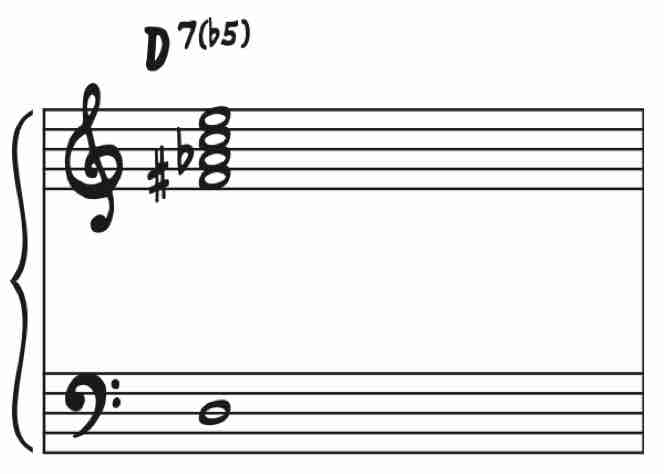
…It doesn’t mean you have to played the exact notes in the chord voicing every time, in fact, there are several ways to approach this chord that sound consonant depending on what you’re going for.
Let’s take a look at how Desmond treats this tricky chord…Have a look at what he plays in his first chorus…

Notice that he’s basically treating it like a normal II7 chord? Sure, he touches the b5/#11 at the end of the line, but this is more of an approach tone to the 5th of the next chord.
And this is the first principle that you should take from Paul over this chord: Treat it first and foremost as a II7 chord, a standard dominant chord.
Much of the time, we see an alteration like a b5 in a chord, and feel that we absolutely must highlight this alteration, that it’s the defining trait of the chord sound.
But as Desmond demonstrates, this is not so much the case. Take for example this point in his solo, where he sticks to primarily the D triad…

Or at another point, when he plays straight up the D7 bebop scale.

So that’s the big lesson when it comes to this chord in Take The A Train, that it can be treated just as a normal II7 dominant chord, and that you don’t need to go crazy with scales to unravel its mystery.
Keep in mind though, in this recording, the pianist Dave Brubeck, is not holding out the chord sound for the full measure. He’s just tapping it lightly for a second, so the chord sound is quite open.
On the other hand, if you have a pianist that’s just sitting on this chord for days, and holding out the II7b5 chord voicing for the entire measure, then you might need to be more careful – in other words, if you’re holding out the natural 5th, it might clash against the b5 in the voicing.
Now, getting to the b5 alteration, Desmond addresses this sound later in his solo in a most elegant way.
By using an E major triad over the D7 chord, he easily emphasizes the 9th, #11/b5, and 6th/13th of the D7.

This is a simple and great trick to use if you want to bring out that b5 sound. Just play a triad a whole step above the root (E major triad over D7)
Now besides the b5 sound over this D7b5 chord, a #5 actually works as well, even though it’s not notated in the chord. And it works because of the nature of the chord sound.
Have a listen to how the #5 would sound over this D7b5 chord…I’ll play the chord for a second before I add the #5 an octave higher on top so you can clearly hear it.

Here’s the thing about this sound – Because of the notes in the chord voicing, and the #5 on top, when you reorder these notes into a scale, you naturally get all whole steps between the notes…
So what you end up with is a Whole Tone Scale – a 6 note scale that consists of notes that are all a whole-step apart.

Keep in mind, this whole tone scale sound is not coming from some blind scale-choice from chord scale theory – we’re not just picking a scale and running with it.
Rather, this scale comes about directly from the intervallic content of the chord voicing, paired with the #5 – this is what creates this sound and this is why it works.
So as you can see, there are quite a few options on this chord sound that make sense.
To sum up:
- Treat it as a normal II7 chord – Use dominant language, emphasize the 3rd of the chord, the tonic triad, or use bebop scales, but make sure to pay attention to how the pianist is comping. If they’re sitting on the D7b5 chord voicing for an extended period of time, use the natural 5th with care.
- Use the b5 – Use this chord tone to explicitly match the chord voicing sound. An easy trick is to use the triad a whole step above the root, E major triad in this case.
- Use the #5 – From the intervallic content created by the chord voicing with this chord tone, you end up with a whole-tone scale sound.
These are 3 solid options over the second chord in Take The A Train, and when you understand how to use them, why each works, what to watch out for, and what they sound like, this part of the tune that gives most people trouble will become easy for you.
3. Think Rhythm FIRST
Although Paul Desmond is possibly the most melodic player to ever live, much of his genius lies in a different domain – his use of rhythm.
In fact, it just might be his interesting rhythms that make his melodies come to life. Take for instance these 8 bars of his solo that we looked at earlier and this time try to hear what he’s doing rhythmically.

It’s not easy to see, but if you listen, you can hear that he’s repeating the same rhythm over and over throughout this section of his solo.
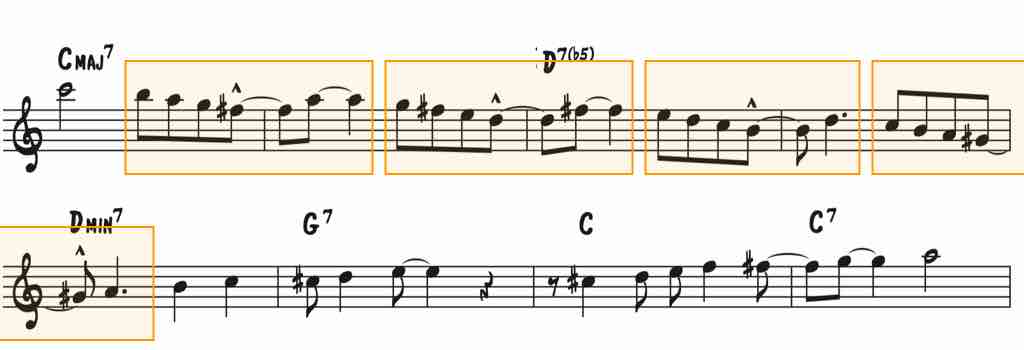
This improvisational concept is known as Rhythmic Sequencing, and it’s something Paul Desmond does a lot.
Or sometimes, he’ll even play a rhythm, then play something else, and then come back to the first rhythm as he does in this part of his solo…

Again, he sequences the rhythm, but mixes in something in between.
And another thing to think about in terms of the way he uses rhythm is the actual rhythms he uses – he frequently syncopates rhythms, changing the emphasis in hi slin from the downbeat to the upbeat.
For example, can you hear how he’s using syncopation in this line?

Over the G7, he plays an eighth note leading into a quarter note.

This combination is perfect for setting up syncopation.

And in the second part of the line, he uses an 8th note rest before a quarter note…

And just like an eighth note followed by a quarter note, this combination is another perfect setup for syncopation.

Paul Desmond is a master of rhythm and you can be too by thinking rhythm first.
Work on…
- Sequencing rhythms by repeating them through the changes
- Playing a rhythm, playing something else, and then returning to the original rhythm
- Integrating syncopation into your playing using the two setups we talked about
These rhythmic devices that Desmond uses are simple and effective ways to add a whole new level of rhythmic inte
4. Use a Motivic ii V7 Approach
Another unique aspect of Desmond’s playing over Take The A Train is how he approaches the ever present ii V7 I progression.
Rather than playing over it in a very predictable scalar way, he instead implements his syncopated rhythms and often plays through them in a motivic way.
Take another look at the syncopated line we just looked at right before bridge and see if you can understand what he’s doing melodically and harmonically.

He uses a syncopated approach note to the 5th of the minor chord (D minor) and the 5th of the V7 chord (G7). Then he sequences this motif to the next two bars by viewing them as a ii V7 of IV, G- C7 headed to F Major.

Playing over ii V7s with motifs and syncopated approach notes like this is anything but normal.
The next time you play over a ii V7, which will probably be today, try thinking motivically the way Desmond does and you’ll definitely see new doors open in your playing.
And another very interesting place where Desmond approaches ii V7s in a unique way happens here…

This might be a little tricker to figure out on your own. Any ideas?
If you listen closely, you can hear that he’s subbing out the original V7 chord for a V7 chord a tritone away (Using Db7 in place of G7).

As you probably know, this is called Tritone Substitution, and while usually thought of as a modern device, it’s a classic technique used throughout the history of jazz.
By using the Db triad over G7, he emphasizes the #11/b5, 7, and b9 of the G7 chord.

But just like before, pay close attention to his use of rhythm and how he creates a rhythmic motif through the ii V7. This is what makes the line come alive…
It’s his genius use of rhythm, combined with his harmonic and melodic skills, that allow him to approach ii V7s in a unique fashion.
Take some time to get your head around what he’s doing here so you can use this powerful motivic technique in your own playing.
5. Use Quotes in an Interesting Way
The final technique we’ll look at today has to do with how Paul Desmond integrates quotes into his solos.
Quoting pieces of other tunes within your solo is a common technique that many jazz musicians use to give their listeners little pieces of recognizable ear-candy that make them perk up…
But the particular way Paul Desmond uses them is a little different than most. Rather than being so explicit and direct with his quotes, he hints at them and uses them as a part of his rhythmic and melodic concept.
Even the opening of his solo sounds similar to the famous tune Without a Song, but he doesn’t go overboard with it, so it leaves the listener guessing a little bit…

And he does this again here, playing a few notes from the classic standard Indiana…

Or in this part of his solo, he clearly plays the defining line of There Will Never Be Another You, but again, it’s integrated into his solo in a natural way…

And here, he suggests the melody from the tune Four but plays with the rhythm a little bit…

It’s amazing that in this single solo, he quotes so many tunes, but perhaps this is a clue into how Paul Desmond became such a melodic player in the first place.
If he can quote nearly any tune, at any time, in any way he feels like, clearly he studied the melodies of tunes very closely, learning them in different keys, understanding the rhythms behind them and their defining melodic traits.
Through this study, anyone would glean a ton of valuable information about how to compose and improvise beautiful melodies for themselves.
So do as Paul did, and take small fragments from tunes that you like and work with them:
- Practice them around The Cycle
- Extract the rhythmic content and study it
- Understand the defining melodic components
Like Desmond, by studying the melodies of classic jazz standards and learning what makes them tick, you’ll unlock the tricks to melodic playing.
Paul Desmond’s Secrets to Take The A Train
Well at this point, by carefully going through today’s lesson, you should have a deeper knowledge about the chord changes to Take The A Train and have a better idea about how you might approach soloing over them.
Remember, when you combine Paul Desmond’s 5 strategies over this classic jazz standard, you’ll have a lot more creativity to explore…
- Learn to use guide tone lines in a musical way
- Understand how to approach the 2nd chord
- Apply syncopation and rhythmic sequencing
- Try approaching ii V7s in a motivic way
- Integrate quotes into your lines
Take The A Train is not some cheesy tune to overlook – it’s a classic tune that contains essential chord progressions that you need to be able to deal with.
Take your time with this and really study Paul Desmond’s solo. In time, you’ll come closer to singing melodically through the chord changes, just like him.










